Blackbeard: A Comprehensive Exploration of the Fearsome Edward Teach
Author: Krzysztof Wilczynski
Introduction to the man with the Black Beard
Few command the intrigue and fascination that Edward Teach does. Known more commonly as Blackbeard, his name alone is enough to conjure images of high-seas adventure, daring exploits, and a touch of the macabre. Blackbeard was not just a man, but a symbol of an era when the world was still being explored, and the line between villain and hero was as blurred as the horizon at sea.
Edward Teach, born around 1680, was a man of his time, yet he transcended it. He was a product of an age of exploration and exploitation, where the promise of wealth and the threat of violence were two sides of the same doubloon. His transformation into Blackbeard, the most feared pirate of his day, was as much a testament to his own audacity as it was a reflection of the lawless era he lived in.
Blackbeard's reign of terror on the high seas lasted a mere two years, from 1716 to 1718, but his legacy has endured for over three centuries. His thick black beard, from which he derived his fearsome moniker, and the slow match fuses he lit in his hair during battles, created an image of terror that has become synonymous with the very concept of piracy.
Yet, Blackbeard was more than just a pirate; he was, and continues to be, a cultural phenomenon. His life and exploits have been romanticized, dramatized, and immortalized in countless books, movies, and television shows. From his portrayal as a cunning and ruthless pirate in the "Pirates of the Caribbean" franchise to the complex and charismatic character in the TV series "Black Sails," Blackbeard's influence permeates our popular culture.
But who was the man behind the black beard? How did Edward Teach, a man from Bristol, England, become Blackbeard, the most notorious pirate in history? And why, after all these years, does his story continue to captivate us?
In this comprehensive guide, we will delve into the life and legend of Blackbeard. We will explore his transformation from Edward Teach, an ordinary seaman, to Blackbeard, the pirate whose very name struck fear into the hearts of sailors. We will examine his audacious exploits, his dramatic downfall, and his enduring legacy in both history and popular culture.
So, prepare yourself for a journey into the world of Blackbeard, a world of adventure, danger, and legendary figures. Welcome to the world of Edward Teach, the man known as Blackbeard.
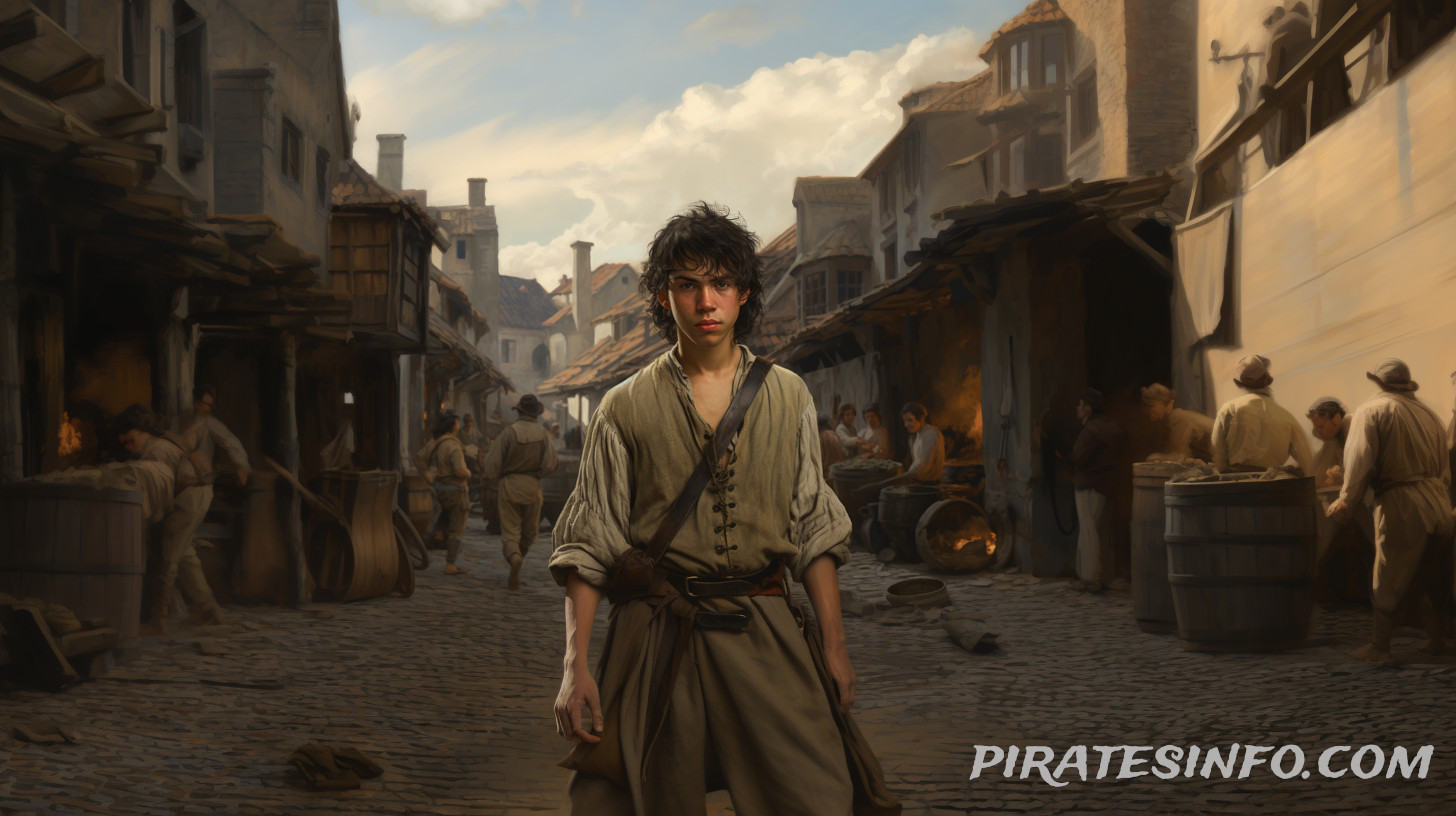
Edward Teach: From a Bristol Boy with Black Hair to an Infamous Pirate with a Black Beard.
On the southwestern shore of England, in the bustling port city of Bristol, a boy named Edward Teach was born around 1680 (Cordingly, 2007). Picture a city alive with the constant ebb and flow of merchants, sailors, and laborers - a place where the tang of sea salt mixes with the earthy smell of cargo, a city resonating with the cacophony of hooves clattering on cobblestone, sailors bellowing shanties, and merchants calling out their wares. This is the vibrant tapestry of sounds, sights, and scents that would have greeted young Edward Teach daily.
Teach’s family likely belonged to the humble ranks of the working class (Rediker, 2004). Picture the long hours his father might have toiled, perhaps as a dockworker, loading and unloading cargo under the stern gaze of ship captains. Or maybe he worked as a tradesman, the sharp scent of wood shavings forever clinging to his clothes. His mother might have washed the laundry of richer families, her hands red and raw from the harsh lye soap. Money was scarce, and luxuries even scarcer.
Growing up, Edward would have known the hardship of laboring for a meal, the heartache of seeing his parents' ceaseless toil, and the biting cold of a winter's night with insufficient coal for the fire. But amidst the labor and poverty, there was also joy and camaraderie. Imagine him as a lad, scampering through narrow lanes and busy docks, his laughter echoing against the city’s aged, stone walls. The docks, with their towering ships and tales from distant lands, would've fascinated him, planting the seeds of an ambition that would eventually outgrow the confines of Bristol's docks.
In his teenage years, Edward's life took a pivotal turn. The War of Spanish Succession (1701-1714) created a demand for privateers – essentially legalized pirates (Konstam, 2007). Edward, then a strapping lad with a spark in his eyes, was ripe for the adventure. With the prospect of earning far more than his father ever could, the young Edward was likely drawn towards privateering like a moth to a flame.
When the war ended, privateers like Edward found themselves in a precarious position. With no enemy ships to legally plunder, they were left with two choices: return to the drudgery of land-based work or continue the thrilling but illicit life at sea. It was at this crossroads that Edward Teach chose the latter, birthing the pirate legend known as Blackbeard.
Living conditions of the era, coupled with the seductive promise of wealth and freedom that piracy offered, tipped the scale for Edward (Woodard, 2010). His decision was not born out of inherent wickedness, but rather out of a desire for a life less ordinary. A desire born on those docks in Bristol, where as a lad, he dreamt of the wide-open sea and tales of distant lands.
Blackbeard’s life and transformation provide a captivating glance into an era of stark contrast – a world where dreams were often bigger than means, and choices were dictated more by necessity than desire. To understand Blackbeard, we must first understand Edward Teach: the boy from Bristol who dared to dream.
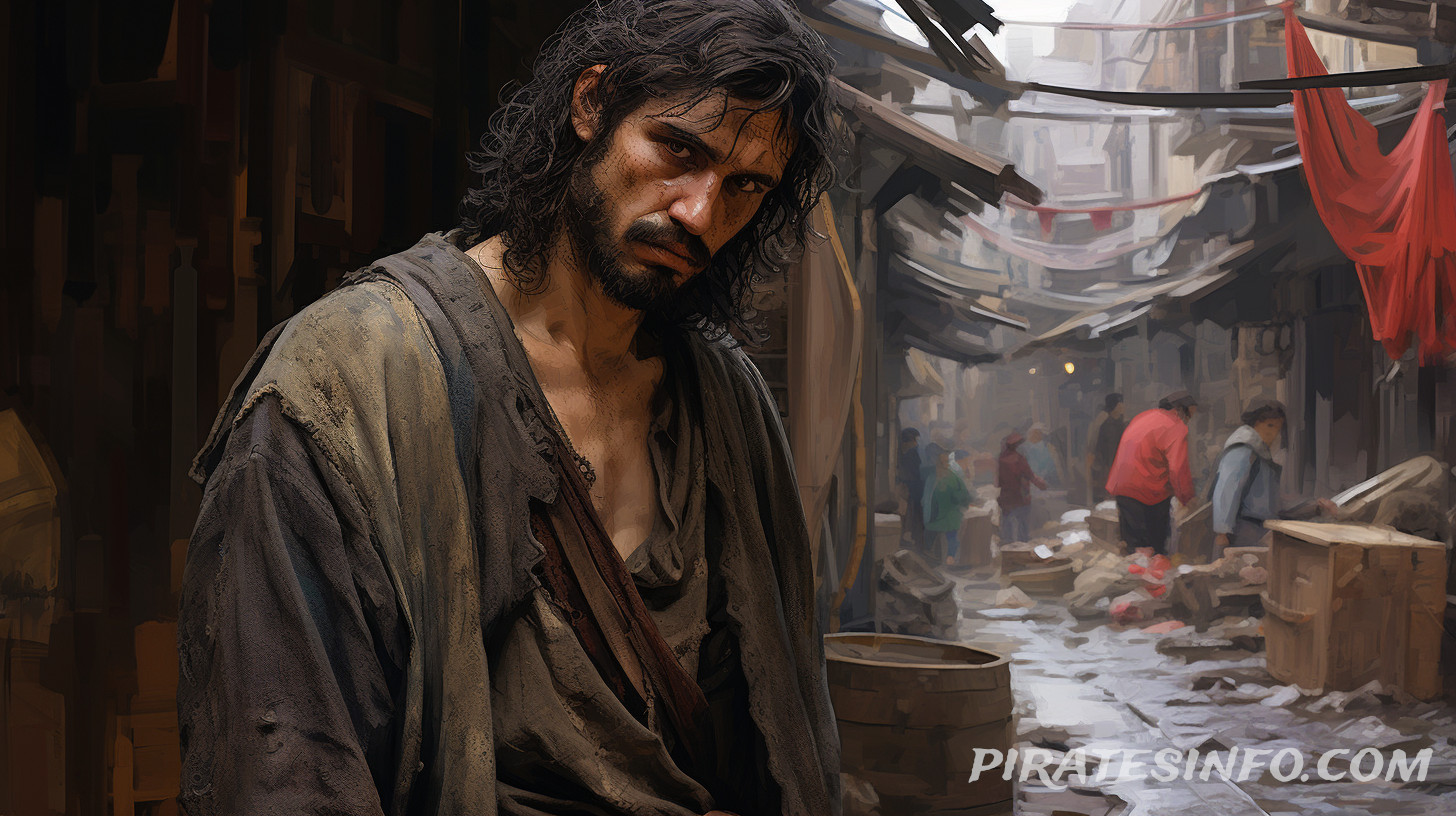
Breaking Blackbeard from Edward Teach
In the brutal, mirthful, and altogether enthralling realm of seafaring piracy, a specter was in the making. Edward Teach, once an ordinary sailor on a weather-beaten privateer ship, was on the cusp of an extraordinary metamorphosis. Against a backdrop of pounding waves and volatile winds, Teach stood on the edge of an unforgiving world, ready to reinvent himself as the infamous pirate, Blackbeard.
Teach had known the biting harshness of poverty in Bristol. He'd tasted the bitter gall of a laborer's existence, where dreams were often trampled under the relentless grind of survival. In the underbelly of a bustling port, he had glimpsed the fortunes that awaited those brave or desperate enough to reach out and claim them. Teach yearned for more than the hardscrabble life he was born into. He sought the taste of gold and the heady thrill of freedom.
Transforming into Blackbeard was no mere change of name, it was a fundamental shift in identity. Blackbeard was Edward Teach amplified, a figure as compelling as he was terrifying. The origin of his name harks back to his thick black beard, a feature he twisted into intimidating braids that lent him an air of feral menace (Konstam, 2007). But this alter ego was as much about securing his financial future as it was about intimidating his adversaries.
Edward Teach emerged from the War of Spanish Succession with a keen understanding of the lucrative prospects piracy offered. The life of a pirate provided him with an opportunity to seize control of his destiny in a way a common sailor or laborer never could. Teach, armed with audacity and a potent hunger for affluence, recognized this potential and adopted the pirate life.
Blackbeard was not just a dread pirate, but also a shrewd businessman. He ruled by reputation and fear, but also by an astute understanding of economics and human greed. Beneath the terrifying façade of a demonic figure with slow-burning fuses in his beard (Rediker, 2004), was a calculating mind well-versed in the balance of power and profit. This theatrical display of intimidation often meant the difference between a profitable venture and a costly battle.
Ruthless when necessary, Blackbeard embodied a calculated form of violence. Every act, every display of ferocity was a carefully orchestrated strategy to maintain his control over both his crew and his victims. He knew that a strong reputation could command obedience, allowing him to keep his operations profitable without excessive expenditure on battles and losses. He was, above all, a pirate who understood the intricacies of supply and demand on the high seas.
The narrative of Blackbeard is thus one of a man seizing control of his destiny, driven by a thirst for freedom, power, and wealth. It's a captivating tale of a sailor turning into a merchant of fear, using reputation as his currency and commanding respect in a world where the boldest often claimed the biggest prizes. Even today, centuries later, the name 'Blackbeard' resonates as a symbol of a pirate's thirst for gold, ambition, and the absolute command over one's fate.
As we delve deeper into the annals of Blackbeard’s exploits, we find ourselves drawn towards the stories of his fleet, his men, and most intriguing of all, his flagship - the Queen Anne's Revenge. How did this man, born Edward Teach, manage to amass such a formidable fleet? How did he inspire loyalty and fear among his crew in equal measures? The answers to these questions lie in the shadowed labyrinth of Blackbeard's life, a journey that takes us further into the heart of the Golden Age of Piracy.
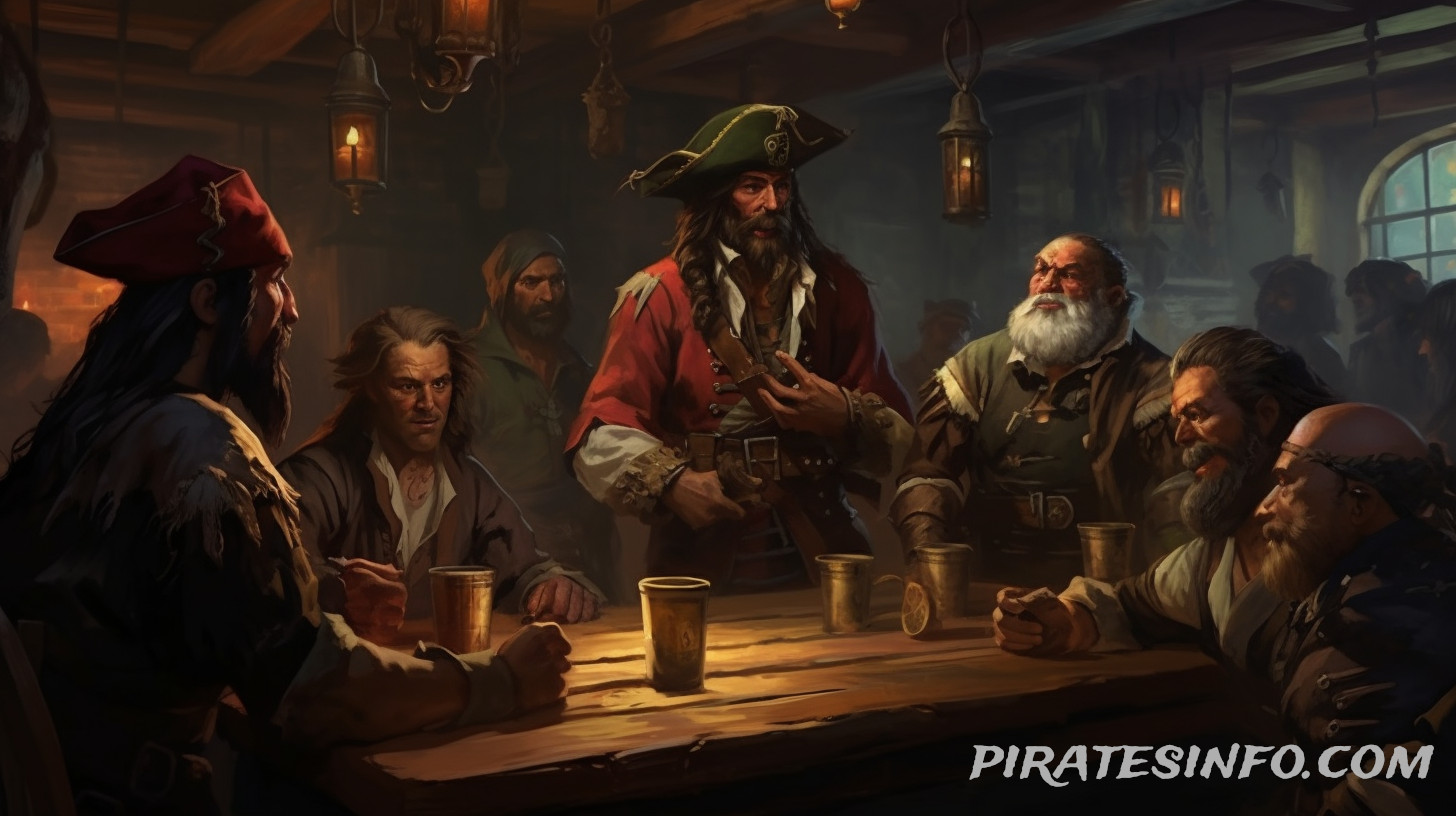
Blackbeard's Crew: Convincing Ordinary Men to Pirate Life
Imagine a smoky tavern, perched on the edge of a bustling port, its low ceilings wreathed in a haze of pipe smoke, the air a blend of spilt beer, damp wood, and the briny tang of the sea. This is where Blackbeard hunted for his crew, among men hardened by years at sea, their dreams of wealth and adventure still unfulfilled. The siren's song of piracy was a compelling one, promising freedom, fraternity, and fortune.
Blackbeard knew how to weave a potent tale. His charisma and sheer physicality set him apart. Picture a man towering above the crowd, his beard a black curtain twining with slow-burning fuses, his voice a gravelly symphony that commanded attention. He'd share tales of plunder, of the thrill of boarding a rich merchant vessel, of the taste of fine wine stolen from a king's cargo. He painted piracy not as a dangerous endeavor but as an act of rebellion against a system that paid them pennies for risking their lives (Rediker, 2004).
The dynamics within Blackbeard's crew were a careful equilibrium of camaraderie and command. Within the tight confines of a ship, disagreements could quickly escalate into mutinies. Blackbeard navigated this potential minefield with a firm hand and an understanding of human nature. He dealt swiftly with dissent, but he was no brute. His rule was based on respect, not fear. He was as quick to share a laugh with his men as he was to discipline them, reinforcing a sense of unity and shared purpose (Konstam, 2007).
The division of loot under Blackbeard's command was a democratic affair. Imagine the anticipation as the spoils were divided, the crew gathered around, eyes gleaming with avarice and excitement. Blackbeard would ensure that each man received his fair share, a marked departure from the practice on navy or merchant ships, where wealth was a privilege of the officers. This practice fostered a sense of equality, further cementing his crew's loyalty (Cordingly, 2007).
Blackbeard's reputation preceded him. He was a figure of awe and dread, a man who dared defy kings and empires, a symbol of defiance in an era of strict social hierarchies. To those desperate enough, he was an inspiration, a man who had seized his destiny with both hands. To others, he was a nightmare, a demon of the seas who could appear from the mist and change their lives in an instant (Woodard, 2010).
Recruiting his crew was more than just gathering able-bodied men; it was about building a brotherhood, a family united by a common purpose. These were men who chose a life outside society's norms, inspired by Blackbeard's charisma and the promise of a life less ordinary. They were a testament to Blackbeard's skill as a leader and a manipulator, to his ability to turn dreams into reality.
Blackbeard's Armada: Master of the Seas
In the annals of maritime history, Edward Teach, known to the world as Blackbeard, etched his name not just with his fearsome persona but with the undeniable force of his formidable fleet. This was no mere ragtag collection of vessels; it was a symbol of his audacious ambition, a manifestation of his strategic acumen and a testament to his maritime dominance. So, how did a former privateer turned pirate ascend to command such an imposing fleet?
Our narrative commences on a fateful day in November 1717, when the French slave ship 'La Concorde' fell prey to Blackbeard and his seasoned crew, who numbered 150 men (Cordingly, 2007). Envision the gripping scene: an innocuous ship emerging from the vast horizon, growing threateningly larger as it nears, its true, chilling identity dawning - it was a pirate ship, commanded by none other than Blackbeard himself. Despite her superior size, the La Concorde found herself outmatched against the relentless onslaught of Blackbeard's men.
After claiming the French vessel, Blackbeard christened her the 'Queen Anne's Revenge', transforming her into a dread-inspiring fortress at sea, equipped with 40 guns. Imagine the terror it incited, this monolithic ship bearing Blackbeard's dreaded flag, a harbinger of doom to all unfortunate enough to cross her path.
But the Queen Anne's Revenge was just the centerpiece in Blackbeard's seafaring enterprise. He capitalized on the post-war maritime chaos, accumulating a fleet of several vessels, each an integral part of his naval apparatus, each overflowing with hardened pirates ravenous for wealth and the thrill of lawless life. This was no motley assembly; it was a disciplined, organized force, steadfastly loyal to its commanding captain.
Such a feat - maintaining control over a large, diversified group of buccaneers spread across numerous ships - was a rarity among pirates. It demanded more than brute force; it necessitated an understanding of the pirate psyche, their drives and desires. Blackbeard, ever the cunning strategist, understood precisely what drove his men: the tantalizing allure of untold riches and the intoxicating liberty of life beyond the law (Konstam, 2007).
His leadership methodology was a meticulous balance of intimidation and respect, underscored by the pledge of potential wealth. Imagine him, towering over his crew, an imposing silhouette against the dying sun, his potent blend of promises and threats wafting across the deck with the sea breeze. His charisma was inescapable, his resolve unyielding.
To effectively govern his maritime domain, Blackbeard partitioned his fleet into smaller, more manageable cohorts, entrusting individual ships to dependable subordinates. The key to his strategy was coordination, a skill at which Blackbeard was adept. He often used his vessels in a concerted flanking maneuver, a common naval tactic known as 'crossing the T' to overwhelm larger, better-armed opponents. This strategy was a grim ballet on the azure stage of the sea – a deadly dance that left his adversaries encircled, outmaneuvered, and decisively defeated.
This was the brilliance of Blackbeard, his unique contribution to the lore of piracy. His capacity to organize and command a full-scale fleet distinguished him from his contemporaries and solidified his place in the chronicles of piratical history. His ships were not mere means of transport; they were the instruments of his indomitable will, extensions of his intimidating presence.
To truly comprehend Blackbeard, we must consider not only the man but also his fleet, as his ships played an integral role in his legend, as vital as his flaming beard and formidable reputation. They were a reflection of his audacious spirit, a formidable force on the high seas, and a chilling testament to the rise of piracy's golden age.
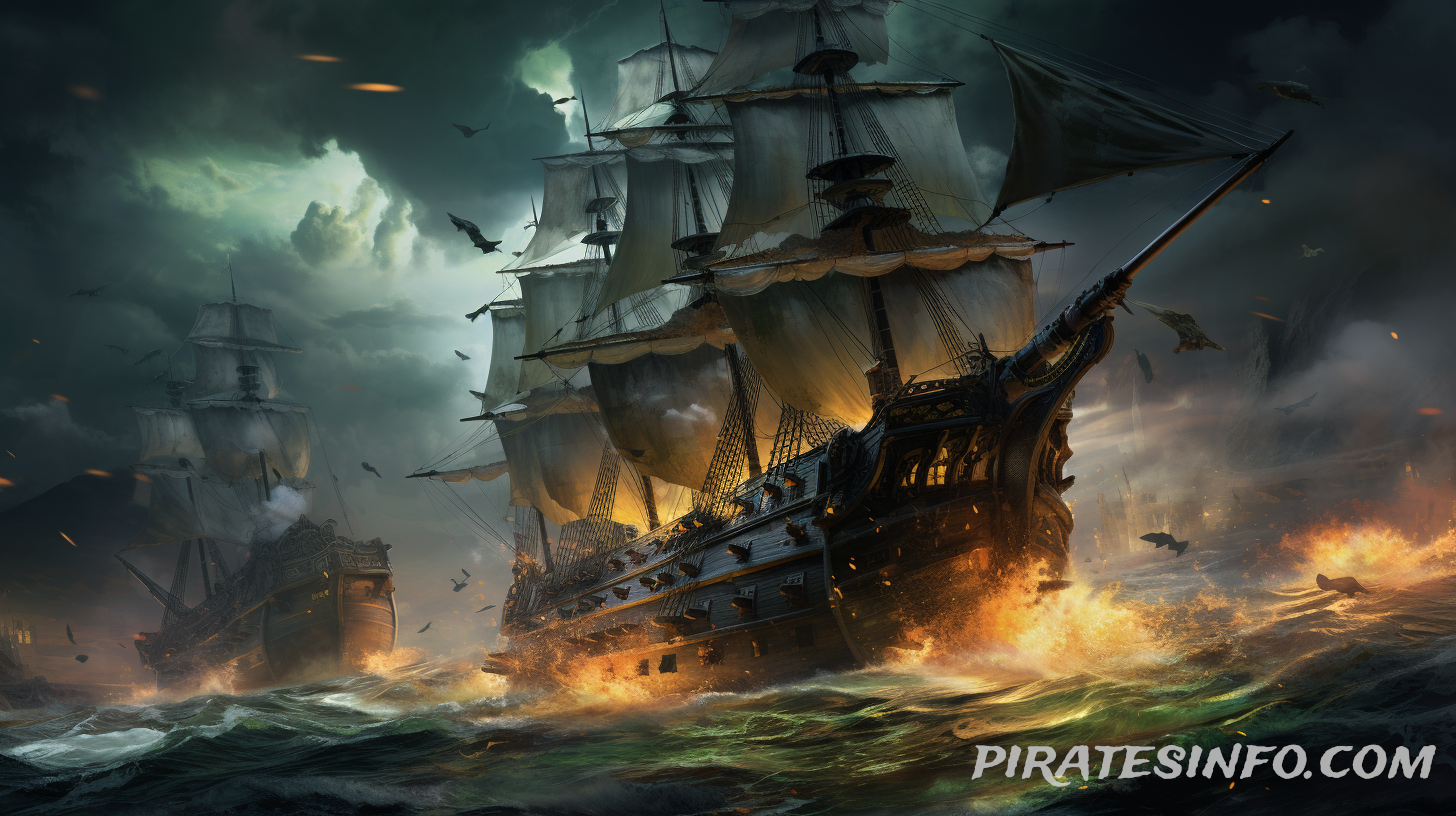
The Capture of Queen Anne's Revenge: A Maritime Coup
In the annals of piracy, the capture of 'La Concorde' – soon to be rechristened 'Queen Anne's Revenge' – was a coup that marked the zenith of Blackbeard's daring exploits. The question arises: how could a pirate, even one as fearsome as Blackbeard, commandeer a larger, ostensibly more powerful ship?
To answer this, we must first appreciate the strategic astuteness of Blackbeard. As any seasoned mariner knows, battles at sea are not won by brute strength alone, but by the judicious application of tactical acumen. Edward Teach, or Blackbeard as we know him, was a master of such tactics. He understood that a pirate's strength did not lie in his ship's size or number of guns, but in the ability to create fear and confusion in his enemies.
When Blackbeard and his crew encountered the La Concorde off the coast of Martinique in November 1717, they were aboard a sloop equipped with modest firepower and a crew of about 150 men. But the La Concorde, despite being a larger ship, was caught off-guard and unprepared for combat. She was a slaver, her crew already diminished by disease and exhaustion, with only a fraction of her guns operational.
Blackbeard, seizing upon this weakness, initiated the attack with a standard pirate tactic: a broadside assault, a volley of cannon fire aimed at the enemy's broadside. As Konstam notes in "Blackbeard: America's Most Notorious Pirate" (2007), "The broadside was designed to cripple the target ship, ideally knocking out its capacity to maneuver or return fire." The broadside's effectiveness lay in its potential for extensive damage, and when accurately executed, it could render the opposing ship defenseless.
The broadside was followed by an audacious boarding attack. Picture Blackbeard, in all his ferocious glory, leading his men in a charge across the grappling hooks and boarding lines, a thunderous cry of defiance echoing around them. This was an all-out, audacious attack designed to sow chaos and panic among the already beleaguered crew of the La Concorde.
The key to Blackbeard's success lay in this combination of strategic naval combat and fearless personal leadership. His ability to incite fear, create confusion, and seize the initiative transformed a seemingly mismatched battle into a decisive victory.
Upon capturing the ship, Blackbeard demonstrated his understanding of psychological warfare by changing the vessel's name to Queen Anne's Revenge, a moniker designed to invoke terror in all who heard it. Blackbeard's reputation was already growing, and the addition of this formidable flagship to his fleet was a clear signal of his growing power.
The capture of Queen Anne's Revenge was more than just a piratical triumph; it was a masterclass in maritime strategy and psychological warfare, marking Edward Teach as one of the most astute pirate commanders of his time.
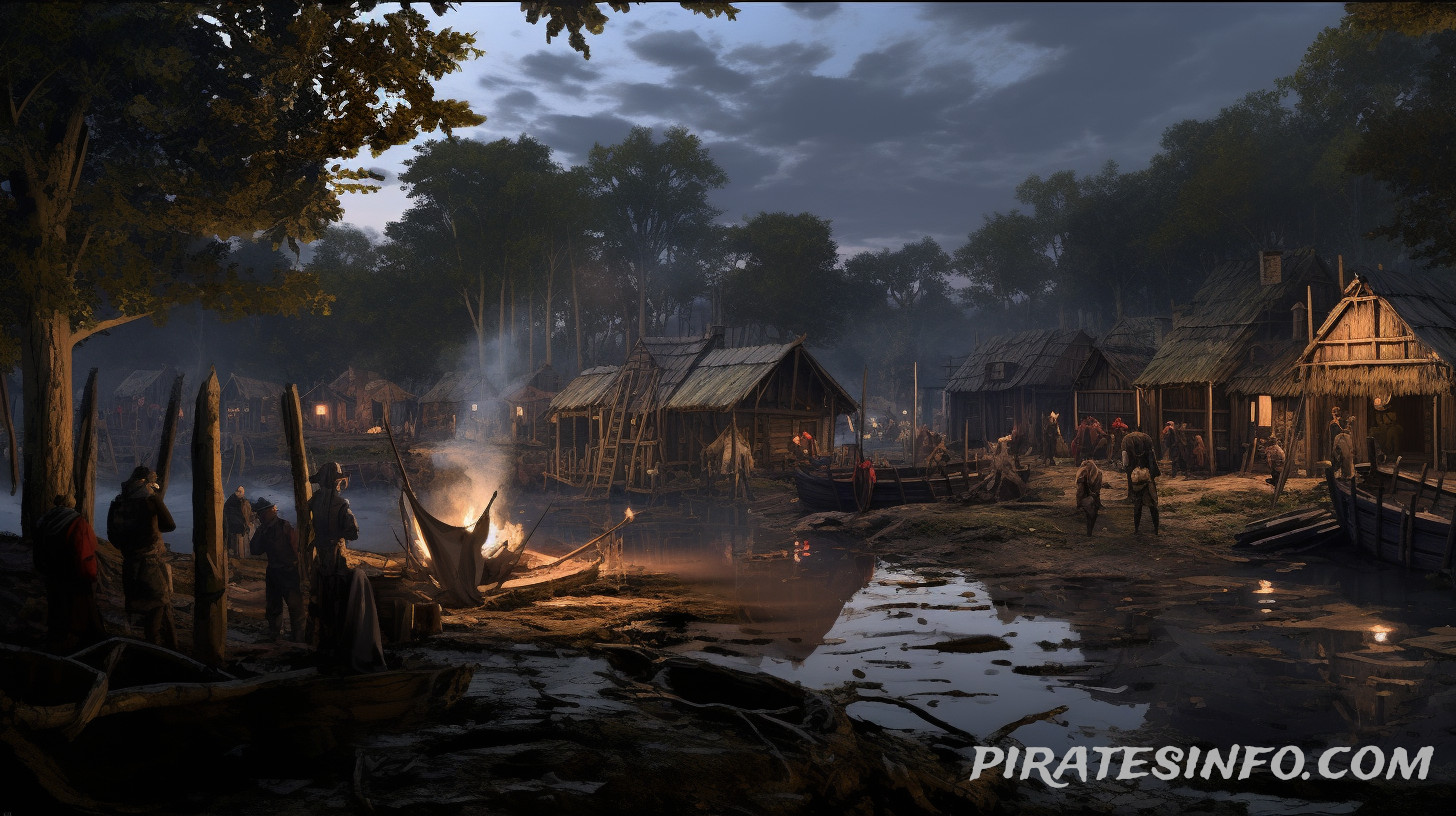
Blackbeard’s Den: The Pirate's Lair and His Plundering Pursuits
A veil of secrecy has always shrouded the infamous pirate Blackbeard's hideout, a lair that, despite the passing of centuries, continues to tickle the imagination of historians and enthusiasts alike. Bath, North Carolina, has long been suspected as the preferred sanctuary of the rogue seafarer (Konstam, 2007). Nestled along the Pamlico River, Bath provided an ideal refuge with its intricate web of creeks and inlets—perfect for a stealthy ship's entrance and exit (Woodard, 2010).
Picture a sunset over the Pamlico: hues of burning orange and molten gold spilling over the calm water, the distant call of gulls, the creaking of ropes as the tide gently nudged against a formidable ship, its ominous figure dark against the fading light. This ship, Queen Anne's Revenge, was more than just a pirate vessel; it was Blackbeard’s throne, his mobile fortress, bristling with forty heavy cannons (Cordingly, 2007). It was a tangible symbol of his power and terror.
Not far off, the small port town of Bath—its buildings mere silhouettes under the expansive, star-speckled night sky—rested in an uneasy calm. Few dared to venture out after dark, their nightly routines dictated by the looming dread of an unseen enemy. Yet, amidst them, unnoticed and undeterred, a tall figure cloaked in shadows navigated through the winding lanes, the hint of a smirk playing upon his lips, his eyes gleaming with audacity and anticipation. This was Edward Teach, the man behind the Blackbeard legend, in his own dominion (Rediker, 2004).
Beyond the town, hidden within the dense, almost impenetrable forest, was the cache where Blackbeard hoarded his loot. Imagine piles of glinting gold, shimmering pearls, precious gemstones, and ornate artefacts, all bathed in the soft, flickering glow of torchlight (Konstam, 2007). Picture Blackbeard, holding up a jewel-studded goblet to the torchlight, watching as the reflected fire danced across the rough wooden walls of the hideout, his deep laughter echoing within the hallowed space.
Yet, the plunder wasn't just about the gold or the gems; it was the thrill of the hunt, the exhilaration of outwitting his pursuers, and the satisfaction of standing in the midst of a pile of wealth that could rival the coffers of any Caribbean governor (Cordingly, 2007). For Blackbeard, each chest of treasure was a testament to his cunning and audacity, each gem a sparkling symbol of a life less ordinary.
His organization of piracy was meticulous. Each raid was planned with precision and executed with an audacity that left his victims reeling (Rediker, 2004). Teach's command over his crew was unquestionable, his authority reinforced by a blend of fear, respect, and the tantalizing promise of wealth. The loot was divided according to the pirate code, a testament to the strangely democratic principles that prevailed amidst the outlaws of the sea (Woodard, 2010).
In the end, the life of Blackbeard was a story of defiance, audacity, and unrestrained freedom. His hideout in Bath and his bountiful cache of treasures weren't just about his prowess as a pirate; they were tangible representations of a man's relentless pursuit of a life lived on his own terms (Konstam, 2007). The echoes of his daring escapades still linger in the legends of Blackbeard, the pirate who dared to defy the world.
Cordingly, D. (2007). Under the Black Flag: The Romance and the Reality of Life Among the Pirates.
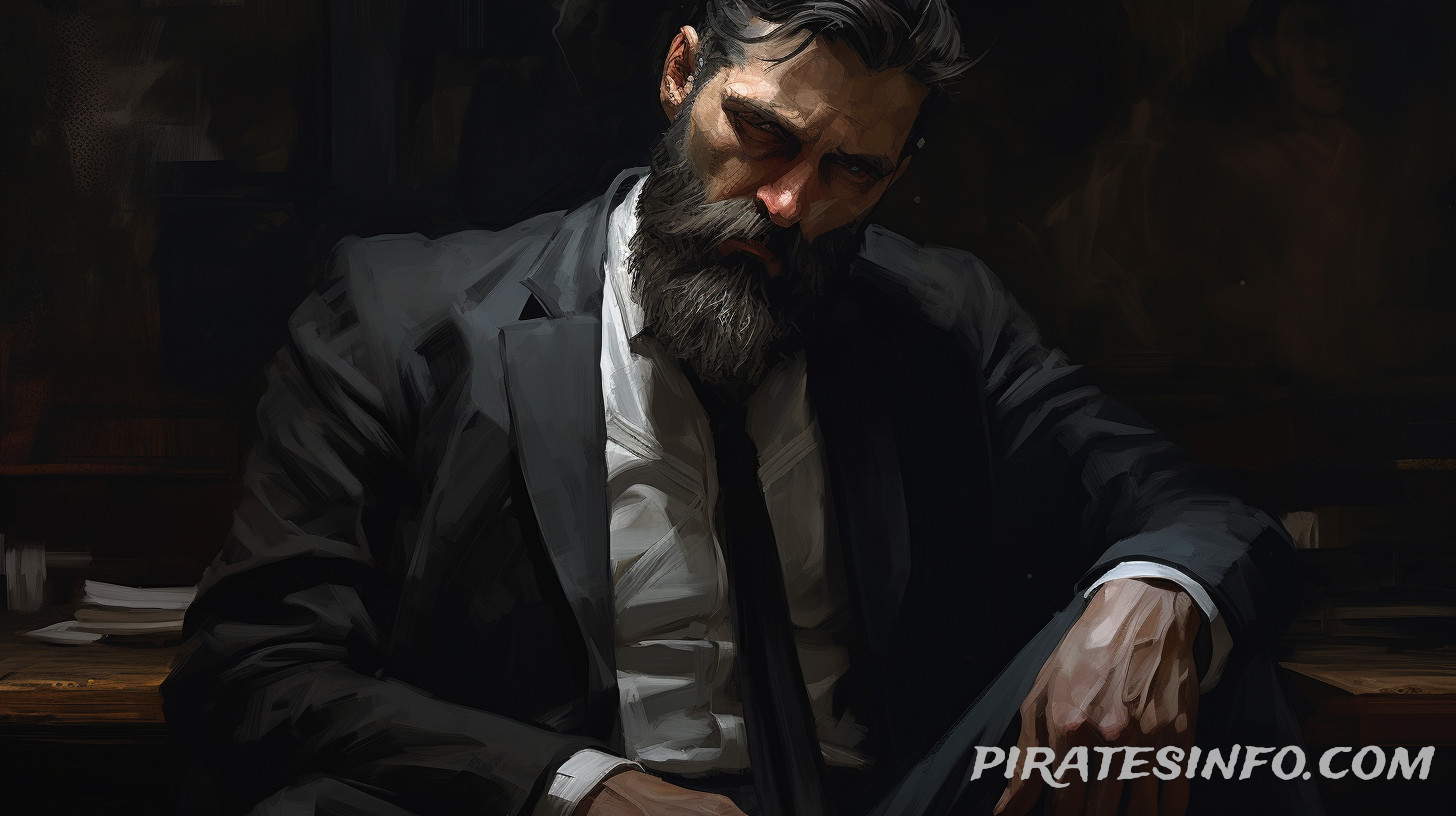
The Entrepreneurial Exploits of Blackbeard
On the surface, Edward Teach, better known as Blackbeard, may not strike as the quintessential entrepreneur. Yet, beneath the grizzled facade of the fearsome pirate was a shrewd businessman and a master of negotiation. His understanding of the complexities of power dynamics, his ability to broker deals, and his uncanny knack for seizing opportunities were akin to those of a modern-day entrepreneur (Konstam, 2007).
The colonial era presented an economic landscape marked by fierce competition, volatile markets, and high-risk, high-reward ventures, not dissimilar to the challenging terrains contemporary entrepreneurs navigate (Rediker, 2004). Blackbeard leveraged these conditions skillfully. He capitalized on the instability of the period, amassing wealth through piratical exploits, whilst deftly maneuvering through intricate webs of power.
Perhaps the most striking instance of Blackbeard's entrepreneurial acumen was his strategic alliance with Charles Eden, the Governor of North Carolina. In a masterstroke of diplomacy, Blackbeard brokered a 'gentleman's agreement' with Eden, securing a safe haven for his operations in exchange for a share in his spoils (Cordingly, 2007). This symbiotic relationship mirrored the partnerships that business magnates today form with governments and powerful individuals, ensuring mutual benefits and stability.
Envision the scene where Eden and Blackbeard meet - a clandestine setting away from the public eye. The negotiation between them would resemble that of a corporate merger, with each party weighing the potential profits and risks. As Eden laid out his proposition, Blackbeard, the pirate entrepreneur, would not just see a lifeline but a lucrative business opportunity (Woodard, 2010).
This alliance was more than a mere act of survival. It was a testament to Blackbeard's ability to think beyond the confines of his immediate circumstances. He envisioned a long-term strategy that offered him protection while simultaneously fortifying his position as a formidable player in the colonial chessboard of power (Konstam, 2007).
Blackbeard's story illuminates an interesting facet of piracy – the intersection of entrepreneurship and lawlessness. His exploits showcase the ingenuity required to thrive in a hostile environment, much like entrepreneurs must do in today's fiercely competitive markets. Through this lens, Edward Teach, alias Blackbeard, emerges not just as a pirate, but as an entrepreneur navigating treacherous waters, a beacon of cunning and audacity.
Ultimately, the tale of Blackbeard is a powerful narrative that echoes even in modern entrepreneurial discourses. It presents a complex portrait of a man who, despite his notorious reputation, could be considered an early example of an audacious entrepreneur, daring to chart his own course in a world dictated by power and profit.
Black Beards Blockade of Charleston
In May of 1718, a dark cloud of dread descended over the thriving port city of Charleston, South Carolina, a city known for its abundance and affluence. The nightmare took shape in the form of a fleet of pirate ships, led by the notorious Blackbeard, who effectively seized control of the city's lifeline – its harbor. It was a daring act, even by pirate standards, and it displayed Blackbeard's audacious spirit and cunning mind. The following week was one of terror and negotiation, a tense standoff that would forever etch Blackbeard's name in the annals of pirate lore.
Blackbeard's demand was peculiar – a chest of medicine. In the disease-ridden world of the 18th century, where even the common cold could spell doom, medicine was more valuable than gold. Pirates, in particular, faced the constant threat of maladies like scurvy, dysentery, and other infections, exacerbated by their lifestyle characterized by poor hygiene, limited diet, and harsh living conditions.
The hostage situation added a new layer of complexity to the blockade. Blackbeard captured several prominent citizens, using them as bargaining chips to pressure the authorities into meeting his demands. Among the captives were Samuel Wragg, a member of the Council of the Province, and other men of significant stature. The pirates treated the hostages well, but the threat was clear – no medicine, no release.
During the blockade, Charleston was on edge. The citizens were terrified, their safety hanging in the balance. Blackbeard, with his fleet, controlled the city's harbor, effectively cutting off its lifeline. The bustling port fell silent, the once lively docks now eerily quiet, the lucrative commerce came to a standstill. The authorities were in a tight spot, with their hands forced to consider the pirate’s outrageous demand.
In the end, the city yielded. To secure the safety of the captives and lift the blockade, they provided Blackbeard with the chest of medicine. And as abruptly as it started, the blockade was lifted. Blackbeard, with his crew, hostages, and now the chest of medicine, slipped away, leaving behind a city grappling with the shock of what just transpired.
This entire event demonstrated Blackbeard's audacity, his shrewdness, and his ability to use fear as a weapon. He was a pirate who not only lived by his own rules but also dared to challenge the established ones. This is what sets the Charleston blockade apart from other exploits of the pirate era and cements Blackbeard’s place as one of history's most notorious pirates.
While the specific details of the Charleston blockade might not be as lavish or laden with treasures, it offers a unique peek into Blackbeard's character and his way of life. It portrays a man who knew how to play on people's fears, to strategize, and to seize opportunities. The man named Edward Teach, known as Blackbeard, had come a long way from his humble beginnings in Bristol. But at his core, he was a man who dared to dream, who dared to break free from the norms, who chose a life of adventure on the high seas – a choice that made him the legend we know today.
In the next section, we'll delve deeper into Blackbeard’s journey, exploring how he managed his fleet, disciplined his crew, and orchestrated his attacks, offering a glimpse into the life and times of one of the most infamous pirates in history.
Black Beard’s Last Stand: Battle at Ocracoke Inlet
The stage was set, the curtains about to lift on the final act of Blackbeard's tumultuous tale. The man chosen to bring down this titan of terror was the intrepid and relentless Lieutenant Robert Maynard of the Royal Navy. This was a man as steadfast and indomitable as the oak his ship was hewn from.
Born to a humble London family, Maynard was no stranger to struggle. He was a self-made man who'd worked his way up through the Navy ranks, a testament to his tenacity and dedication. He was as unyielding as the iron his ship's cannons were forged from, and as cool and calculating as the sea he sailed on.
It was late November of 1718, and the wind carried the sting of salt and the promise of a confrontation. Maynard, commanding the Pearl, along with the Ranger, was entrusted with the formidable task of hunting down the notorious Blackbeard. His crew were stalwart men, their hearts aflame with determination, their minds filled with thoughts of justice.
Maynard set his course, his eyes, steady and unwavering, trained on the horizon. He carried the hopes of a terrorized colony and the daunting task of bringing an infamous pirate to justice. He knew the danger that lay ahead, but the steely glint in his eyes spoke volumes about his resolve.Ocracoke Inlet, with its thin wisps of sand stretching across the azure canvas of the North Carolina coast, was as wild and untamed as the man who chose it as his lair. As dawn broke on that fateful day of November 22, 1718, the rosy fingers of the sun tinged the horizon with hues of gold and pink. Seabirds swooped and danced across the sky, their raucous cries echoing over the gently lapping waves. It was a day like any other, yet, it held the promise of a turning tide in the epic saga of the legendary pirate, Edward Teach, better known as Blackbeard.
Blackbeard’s ship, Adventure, swayed gently at anchor, her hull rising and falling with the rhythm of the sea. Far from the imposing grandeur of Queen Anne's Revenge, his previously commandeered ship, Adventure was a smaller sloop. Yet, it was chosen for the very purpose that Blackbeard thrived on - agility, speed, and the promise of an even playing field against the larger warships of the Royal Navy.
Onboard, the crew reveled in their freedom, a motley group of men who had pledged themselves to the doctrine of 'live free or die.' They were outlaws and rogues, yes, but they were also men who had chosen the wild uncertainty of the sea over the oppressive servitude on land. Men who had opted for the tough but satisfying life where one’s fate was in their own hands, not determined by the whim of an unfeeling master. They were brothers, bound not by blood but by a shared desire for liberty and the spoils of their daring.
As Lieutenant Robert Maynard's sloops, Jane and Ranger, slipped silently through the still morning waters, the crew aboard Adventure were blissfully unaware of the impending storm. Blackbeard, however, stood at the helm, his imposing silhouette etched against the morning light, his keen eyes never straying from the approaching vessels.
The tension broke like a clap of thunder as the first cannonball roared through the air. The initial salvo from Adventure was returned by the navy sloops, their volleys creating an earth-shaking symphony of warfare. Gunpowder smoke filled the air, turning the tranquil morning into a hellish tableau of violence and destruction.
From the belly of the sloops, Maynard’s men sprang forth like avenging spirits, their sabers gleaming in the early morning light. The surprise was complete, and Blackbeard’s crew found themselves outnumbered and outgunned. Yet, they fought back with the ferocity of cornered animals, their every move embodying their unwavering commitment to their creed of freedom.
The battle quickly descended into a gruesome ballet of flashing steel and flying musket balls. Blackbeard, ever the fearless leader, threw himself into the melee. His broadsword sliced through the air, a grim harbinger of death, as he raged against the intrusion of his dominion. His wild eyes and fearsome visage struck terror into the hearts of Maynard's men, even as their own blades sought his life.
Eventually, the inevitable happened. Blackbeard fell, his life extinguished in a blaze of defiance and blood. His final stand would go down in history as a powerful testament to his spirit - a man who chose to live by his own rules and died defending them.
Maynard stood victorious, the bloody feud concluded. Blackbeard's severed head hung from the bowsprit of his ship, a chilling testimony to his fate and a symbol of respite to those who'd lived in his shadow.
The echoes of Blackbeard's downfall reverberated far and wide, marking a pivotal turning point in the Golden Age of Piracy. But death did not diminish Blackbeard’s impact. His spirit lived on, inspiring countless tales and legends, ensuring that Edward Teach, the boy from Bristol who dared to dream of freedom and adventure, would never be forgotten.
References:
Cordingly, D. (2007). Under the Black Flag: The Romance and the Reality of Life Among the Pirates. Random House.
Konstam, A. (2007). Blackbeard: America's Most Notorious Pirate. Wiley.
Lee, R. E. (1974). Blackbeard the Pirate: A Reappraisal of His Life and Times. John F. Blair Publisher.
Rediker, M. (2004). Villains of All Nations: Atlantic Pirates in the Golden Age. Beacon Press.
Woodard, C. (2010). The Republic of Pirates: Being the True and Surprising Story of the Caribbean Pirates and the Man Who Brought Them Down. Mariner Books.